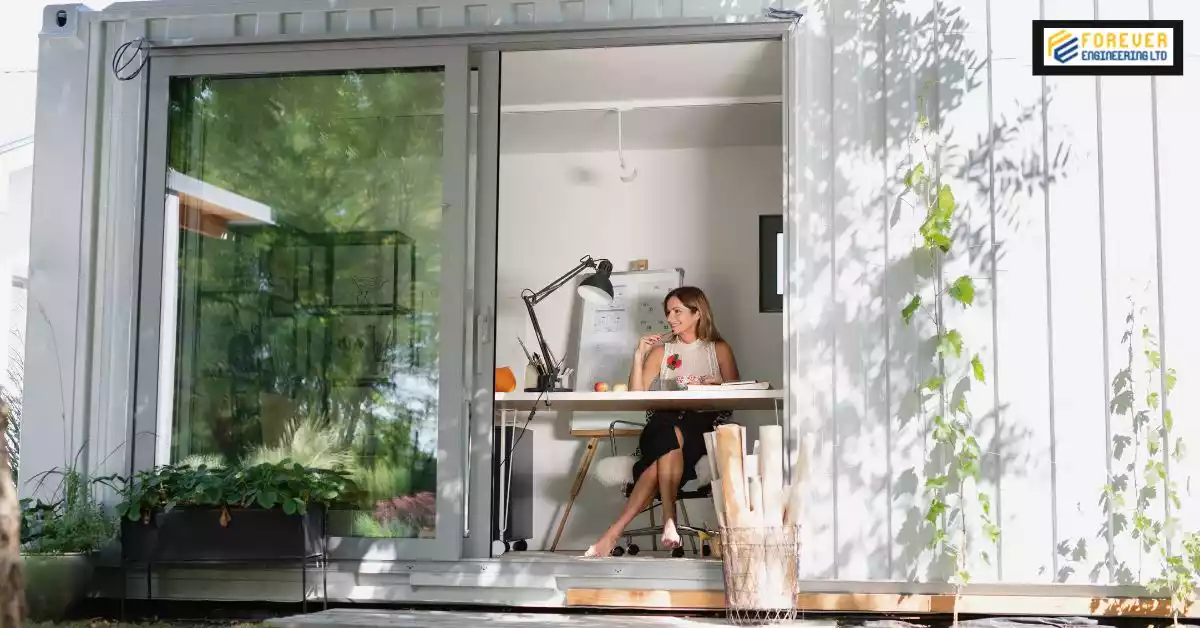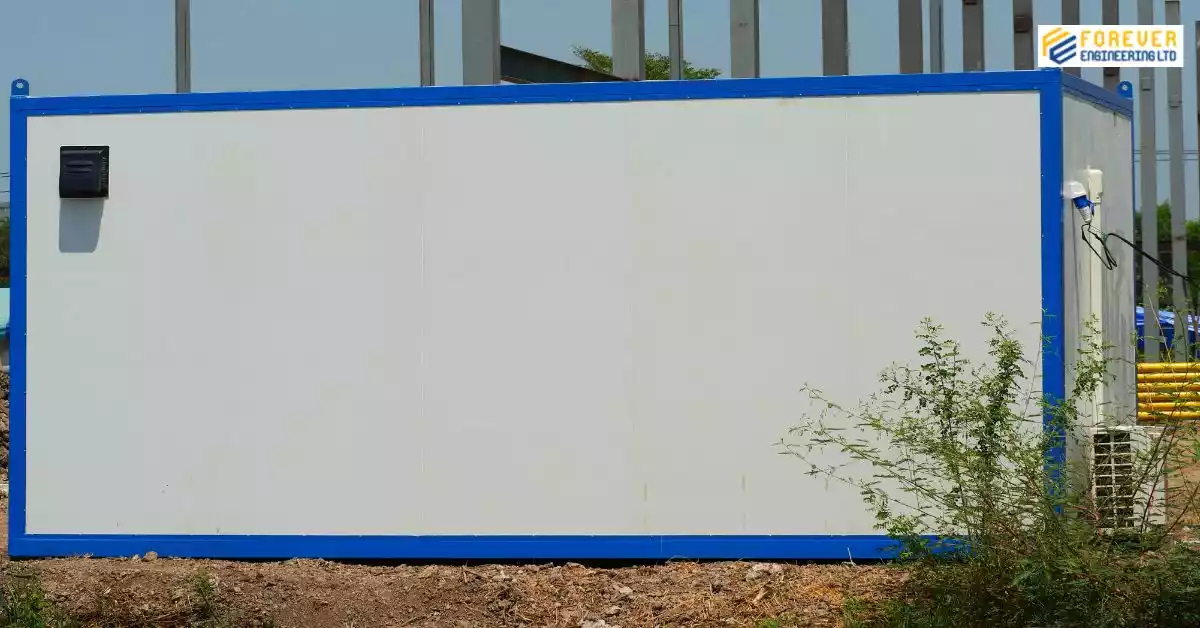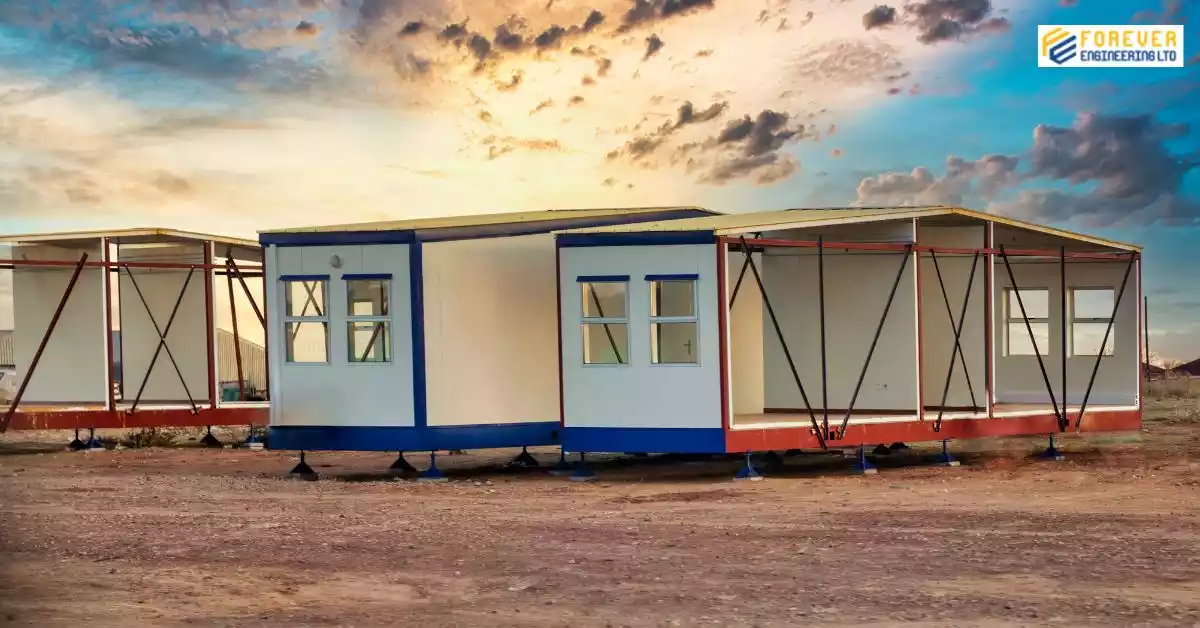Construction offices are mainly for temporary purposes. Buildings are time-consuming and expensive options. However, creating construction offices from shipping containers is an affordable option. Most importantly, it is highly portable and allows for quicker setup. In this article, you will learn the advantages of building a construction site container office and how to create it. Let’s dive in!
Benefits of A Container Office
Table of Contents
ToggleKnowing the advantages of creating a construction office from shipping containers can help you decide if it fits your needs.
1. Sustainable
Building portable construction site offices from shipping containers is an environmentally friendly option. By reusing recycled materials, you minimize on-site waste, unlike traditional office buildings.
2. Spacious
Shipping containers are naturally spacious, so converting several rooms from them is easy. You can also keep your office equipment inside them.
3. Cost-effective
Shipping containers are affordable. The overall construction cost is lower due to faster construction and lower labour costs. You don’t need to bear any concrete and excavation expenses or other building materials.

4. Customizable
Shipping containers are highly customizable to fit your specifications. You can customize doors, windows, walls, insulation, flooring, painting, and finishes, among other things.
5. Transportable
You can move shipping containers to another location. After all, they are mainly pre-fabricated steel boxes. This comes in handy, especially for temporary projects and construction sites.
6. Safe & Secure
Manufacturers use high-quality steel and materials to construct shipping containers. Hence, you don’t have to worry about theft, rust, and other environmental factors.
7. Faster Construction Secure
Due to their pre-fabricated structure, shipping container offices require less time to build than traditional office buildings. By stacking or placing them side-by-side, you can create larger office spaces.
Process of Building a Container Office
When it comes to building storage container offices for construction sites, a step-by-step procedure is required to ensure optimal office functionality and safety.
The following are the steps you want to follow to create a construction office from shipping containers.

Step: 01—Plan About Container Office Design
First, choose an appropriate location to build a construction site container office.
If your area has a lot of space, select large-sized shipping containers to create ample workspace. However, stack containers are better for limited spaces. You can create a multi-story office.
Consider your specific needs and desired work environment to build a good container office.
Step: 02—Choose The Right Shipping Containers
Are you confused about choosing suitable containers for construction sites?
Do you want to create a functional, sleek, and collaborative workspace? Select different shipping containers of various sizes for individual purposes.
For instance, some containers should be used to store tools and equipment. One container is enough to create a meeting room. You can also keep a few others for individual or team workspaces.
If you prefer extra height, buy high-cube containers. Look for containers that have double doors. It can be a plus for construction sites.
Step: 03—Cut The Shipping Containers
The next step is cutting the shipping container to create space for installing doors, windows, and air conditioners.
You can use a zip disc tool, plasma cutting, or an abrasive saw to ensure clean cuts.
Then, install steel frames for doors and windows. They are highly durable and can withstand harsh weather conditions.
Choose impact-resistant doors and windows for construction sites. You won’t have to worry about potential theft or vandalism.
Step: 04 — Weld the Window and Door Openings
Shipping containers have rough edges with many sharp points when cutting the openings. This makes the installation of doors and windows tricky.
It is best to weld steel beams or angles around the openings to simplify installation.
You won’t have to worry about any warping issues, and your container office won’t buckle under pressure. It will create a permanent and secure reinforcement.
Step: 05 — Install Windows and Doors
Now, you can install doors and windows. But what type of doors and windows should you choose for a construction site container office?
It will vary depending on the purpose. For instance, privacy windows are good for meeting rooms, managers or administrative staff rooms, and conference rooms.

Burglar Bar windows are perfect for equipment and material storage rooms, but you can also install extra-large windows in common rooms to create an open, airy feel.
Sliding glass doors are perfect for entry and exit points for easy access and better traffic flow. You can choose lighted doors for a container office with a bathroom, showers, or restrooms.
Step: 06 — Add Insulation To Walls And Ceilings
Add insulation to walls and ceilings to maintain year-round comfort. Plus, it will save costs by reducing energy consumption.
You can choose foam insulation or spray foam insulation based on your preference.
Does your shipping container have limited space? If so, foam insulation is perfect due to its thin layer. Plus, it is simple to install and can prevent rusting issues.
But if your container office has too much uneven space, spray foam insulation is the best. Additionally, it has superior temperature control ability.
Step: 07 — Install the Electrical System and Air Conditioning
The next step is adding all the essential electrical components inside the container office as planned. Choose the right electrical panel and circuits based on the total power requirements.
Don’t forget to use GFCI outlets for bathrooms and break rooms to avoid electrical shock. If you want to install electrical equipment outside the container office, use outdoor-rated outlets and enclosures.
Hiring a professional electrician to comply with the local building codes and safety regulations is best.
Step: 08 — Install Walls, Floors, and Ceiling
Add plasterboards for the walls and ceilings of your shipping containers. This paintable building material can add a clean, finished look to create a professional office environment. It is also simple to install.
However, if moisture is a concern, you can use metal panels. But wood panels are the best for a bold appearance.
Slat wood is one of the best choices for floors. It is easy to install and offers increased airflow. This comes in handy, especially for hot climates. This type of flooring option will also add a unique and natural look.
Step: 09 — Decorate Your Container Office
Add plasterboards to the walls and ceilings of your shipping containers. This paintable building material can give your space a clean, finished look and is simple to install. It can also create a professional office environment.
However, if moisture is a concern, you can use metal panels. But wood panels are the best for a bold appearance.
Slat wood is one of the best choices for floors. It is easy to install and offers increased airflow, which is handy, especially in hot climates. This type of flooring option will also add a unique and natural look.
Services of Forever Engineering Ltd in Building Container Office
We at Forever Engineering Ltd are one of the best container officer suppliers. Our professionals can make standard and customized container offices. Apart from that, we also supply container houses, container restaurants, etc.
Our services include office essentials, decorative items, electrical equipment, and many others. The following are given below:
1. Lighting System
Our professionals can install LED lighting if you prefer long-lasting and energy-efficient options. But we also work on track lighting for focused tasks.
2. Air Conditioning
We can install a packaged terminal air conditioner (PTAC) for single-container offices and a mini-split system for multiple containers.

3. Doors
Our Company supplies various types of steel doors for construction offices that provide increased protection. We also sell French glass doors that can give a spacious feel and provide more natural light.
4. Windows and Shutters
We supply security windows for construction offices to protect office equipment. Our collections also include awning windows, roll-up shutters, hurricane shutters, etc.
5. Kitchen
Our professionals can build a mini-kitchen unit inside a construction site container office to cover basic needs, such as reheating meals, making coffee/tea, and storing basic supplies.
5. Office Furniture
Our Company supplies various types of office furniture, such as desks, chairs, meeting tables, shelves, cabinets, and so forth.
5. Parking
We can create different parking options near a construction container office. For instance, our professionals can build gravel parking lots for temporary use. We also offer defined parking areas for vehicles and equipment.
Frequently Asked Questions (FAQ’s)
Yes, most shipping containers can be converted into office spaces, but the condition and size of the container are important factors to consider. Containers come in standard sizes, usually 20 feet or 40 feet in length, which can be selected based on the space requirement. However, it’s essential to inspect used containers for structural integrity, rust, and damage before purchase, as these issues can affect the safety and usability of your office.
The timeframe for converting a container into an office depends on the complexity of the design, the extent of the modifications, and whether you’re doing it yourself or hiring professionals. Simple conversions with minimal structural changes and basic amenities can be completed in a few weeks. More complex designs requiring extensive modifications, custom fittings, and professional installation of utilities can take several months from planning to completion.
Yes, one of the significant advantages of a container office is its portability. Shipping containers are designed to be moved. However, the ease of moving your office depends on how it’s set up. Suppose your container office is not permanently fixed to a foundation and needs extensive modifications to prevent it from being transported. In that case, you can move it to a new location.
Yes, container offices can be expanded or modified, making them a versatile option for evolving business needs. Because they are modular, you can add more containers to increase space or reconfigure the layout. Modifications can include adding windows, doors, insulation, and custom interior designs to suit different purposes.
Container offices have a long lifespan when properly maintained. A shipping container can last over 25 years with minimal maintenance. The longevity of a container office depends on factors such as the quality of the container, weather conditions, and how well it is maintained, especially in terms of rust prevention and structural integrity.
With the proper modifications, container offices can be made energy-efficient. Insulating the walls, roof, and floor is crucial for maintaining temperature control and reducing the energy required for heating and cooling. Additionally, installing energy-efficient windows and doors, LED lighting, and solar panels can further enhance the energy efficiency of a container office.
Conclusion
When it comes to building a construction site container office, you must consider some important factors, such as space needs, workflow and layout, shipping container size, and foundation. It will help you create a functional, comfortable, and cost-effective construction site office from shipping containers.
We at Forever Engineering Ltd have been in the building construction industry for more than a decade. Our company has earned an immense reputation by supplying high-quality customized shipping containers for household and commercial purposes.

